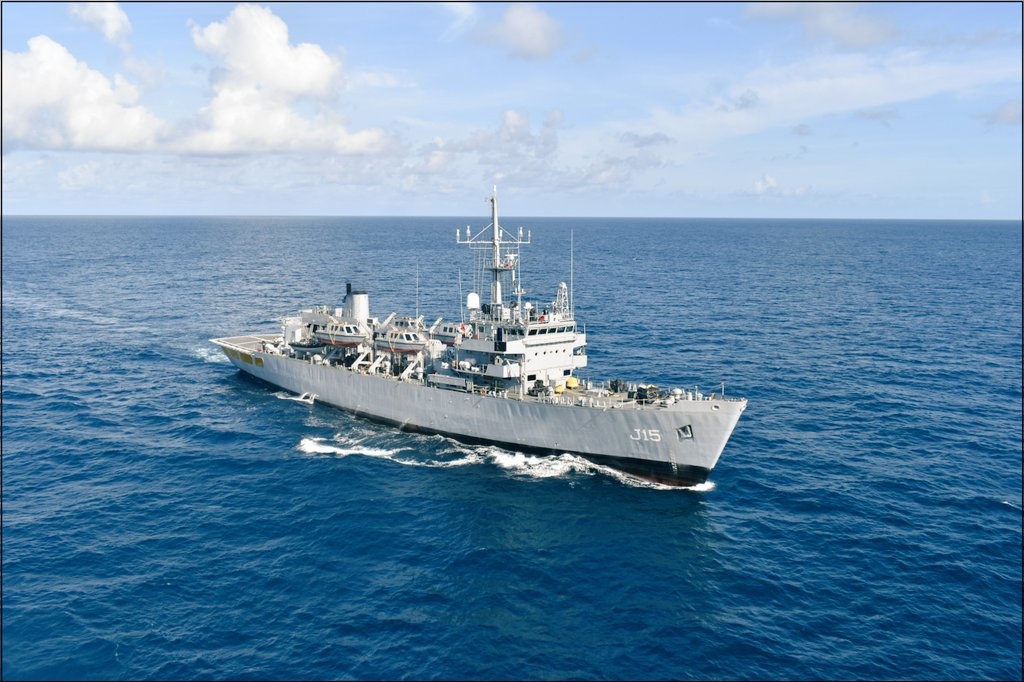INS Sandhayak Charts Its Course: Indian Navy's new era as First Survey Vessel Joins the Fleet
On February 3rd, 2024, a historic moment unfolded in Visakhapatnam as the Indian Navy formally commissioned its first Survey Vessel (Large), INS Sandhayak. This marks a significant leap forward in the Navy's hydrographic capabilities, bolstering its ability to map the vast Indian Ocean region with greater precision and detail.
More Than Just a Ship:
Sandhayak is not just another vessel; it's a powerhouse of advanced technology. Displacing 3,400 tons and stretching 110 meters long, it's equipped with cutting-edge hydrographic equipment. This includes:
- Data Acquisition and Processing System: Processes and analyzes the collected data for detailed mapping.
- Autonomous Underwater Vehicle (AUV): Conducts independent underwater surveys, reaching depths inaccessible to ships.
- Remotely Operated Vehicle (ROV): Provides high-resolution underwater visuals for specific areas.
- DGPS Long-range Positioning Systems: Ensures accurate positioning and navigation.
- Digital Side-Scan Sonar: Creates detailed images of the seabed, revealing potential hazards and underwater features.
Beyond Military Might:
While Sandhayak primarily serves the Indian Navy's defense needs by providing crucial underwater intelligence, its impact extends far beyond military applications.
- Enhanced Maritime Safety: Accurate nautical charts generated by Sandhayak will ensure safer navigation for commercial vessels, reducing the risk of accidents and groundings.
- Scientific Exploration: The vessel's advanced technology can aid in oceanographic and geophysical research, contributing to a better understanding of the marine environment.
- Economic Development: Improved maritime infrastructure and knowledge of underwater resources can attract investments and foster coastal economic growth.
Charting the Uncharted:
Sandhayak's immediate mission lies in meticulously mapping the Indian Ocean Region (IOR). With its sophisticated sonar systems and underwater vehicles, it will map uncharted waters, filling critical gaps in existing nautical charts. This will ensure safer navigation for commercial vessels, reducing the risk of accidents and groundings. Additionally, detailed bathymetric data will be invaluable for:
- Underwater Defense: Precise understanding of the seabed morphology will aid in submarine operations, minefield mapping, and anti-submarine warfare strategies.
- Offshore Resource Exploration: Mapping the seabed paves the way for the exploration and exploitation of mineral resources, contributing to India's economic growth.
- Disaster Management: Accurate underwater data is crucial for predicting and mitigating the impact of tsunamis and other natural disasters.
Beyond Indian Waters:
Sandhayak's capabilities extend beyond national borders. As part of India's commitment to regional cooperation, the vessel can be deployed for joint hydrographic surveys with neighboring countries, fostering trust and collaboration in the IOR. Its participation in international research initiatives can contribute to:
- Understanding Climate Change: Studying the ocean's role in climate change mitigation and adaptation requires comprehensive data collection, which Sandhayak can facilitate.
- Marine Biodiversity Conservation: Mapping the seabed helps identify and protect ecologically sensitive areas, preserving marine ecosystems.
- Sustainable Development: Provide ccurate data to promote sustainable fisheries and marine activities, balancing environmental and economic benefits
A Catalyst for Technological Innovation:
Sandhayak serves as a platform for testing and refining indigenous hydrographic technologies. The data it gathers will be instrumental in developing new sensors, underwater vehicles, and data processing software, propelling India's marine technology advancements. This continuous innovation will not only benefit the Navy but also create opportunities for the Indian marine technology industry.
Sandhayak's impact will go beyond the realm of nautical charts. It is a symbol of India's growing maritime power, its commitment to regional cooperation, and its pursueval for sustainable development. As it embarks on its voyage, Sandhayak promises to chart a secure and sustainable course for the nation's maritime future.
Significantly, Sandhayak boasts an indigenously built content exceeding 80%. This aligns with the "Aatma Nirbhar Bharat" initiative, promoting self-reliance and strengthening the domestic shipbuilding industry. Its construction involved numerous stakeholders, MSMEs, and Indian industries, highlighting the nation's growing technological prowess.
The Road Ahead:
Sandhayak's induction marks a new era for the Indian Navy's hydrographic capabilities. With three more Survey Vessel (Large) ships under construction, the Navy is poised to play a critical role in safeguarding India's maritime interests and contributing to scientific advancements in the Indian Ocean region. As Sandhayak embarks on its maiden voyage, it carries the hopes and aspirations of a nation committed to securing its maritime future.
Key points
- Constructed at the Garden Reach Shipbuilders & Engineers (GRSE), Kolkata, INS Sandhayak is the first of four in the Survey Vessel Large (SVL) ships series.
- The primary role of the Navy’s first SVL is to carry out full scale hydrographic surveys of ports, harbours, navigational channels, routes, coastal areas and deep seas to enable safe marine navigation.
- INS Sandhayak has a displacement of 3,400 tonnes and a length of 110 metres with a beam of 16 metres.
- It is equipped with state-of-the-art hydrographic equipment, including deep sea and shallow water multibeam echo sounders, autonomous underwater vehicles and others.
- INS Sandhayak also features side scan sonars, data acquisition and processing system, remotely operated vehicle, and other advanced features which contain about 80 per cent indigenous content.
- The ship is also capable of serving as a hospital ship during wartime or emergencies, a Hindustan Times report said.
- Sandhayak is powered by two diesel engines and has a speed capacity which exceeds 18 knots.
- This is a restored version of the Navy’s oldest Hydrographic survey vessel, also named Sandhayak, a vessel which was decommissioned in 2021.
- Additionally, the vessel services the requirements of both defence and civil application by gathering and providing oceanographic and geophysical data.
- The vessel’s name, ‘Sandhayak’, means the one who carries out a special search. The crest depicts the 16 points of a mariner’s compass, enclosing a ‘divider’ and an ‘anchor’ riding the sea, symbolising the charting of oceans, which is the basic role of the survey ship.
- This project was guided by the Warship Design Bureau of the Indian Navy.




Comments